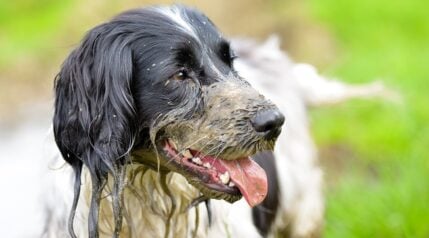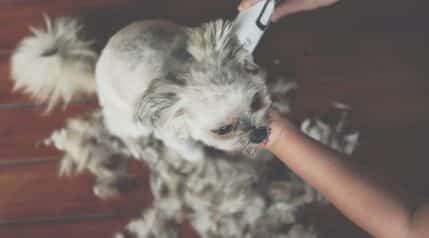So let’s get this out of the way. Pugs shed. They will leave pieces of themselves on your clothing, on your floors, and on your furniture (if you let them). Pugs can have both single coats and double coats. Double coated Pugs naturally will shed more than single coated pugs, because they have more hair. There’s also certain times of year that can impact the frequency of your Pug’s shedding.
The frequency of a pug’s shedding shouldn’t deter you from owning one. Almost all double-coated breeds will shed frequently. For example, the Corgi sheds as much as a Pug, but has longer hair that’s more visible. With any breed ownership, there’s going to be some type of grooming needs and overall health maintenance for your pup. The only exception to this would be a low shedding dog breed which are sometimes classified as Hypoallergenic. If you have pet dander allergies, we’d recommend looking at one of these breeds instead of a Pug.
There are several factors that will impact how much your Pug sheds. This will range from the color of their coat (some coat colors shed more) and the time of year it is. Your pup can also have external factors impact how much hair they drop on a daily basis. We jump into each of these factors, as well as the best way to manage your new Pug’s shedding in the article below. Let’s jump in!
Pug Coats
As mentioned, Pugs can be both single-coated and double-coated. They also come in a few different colors. Pugs can be black, fawn, apricot, and silver fawn. While white Pugs do exist, it’s a form of Albinism and not an actual white coat as other breeds have. If you have a breeder trying to sell you a white pug, you may want to question the legitimacy of the dog, unless it’s a true albino pup.
Most double-coated Pugs are of the fawn, apricot, or silver fawn coat colors. Most Black pugs will have single coats, which means they will shed less. If your heart is set on the Pug breed, but you don’t want a shedder, then the Black Pug is probably your best bet. Keep in mind that black pugs are rarer than their fawn counterparts. Apricot and silver pugs are even rarer. The AKC only recognizes black and fawn coats, so that’s something to think about if you are looking for a show dog.
Why Do Pugs Shed So Much?

Pugs shed, and they shed a lot. This is because they have more hair packed into their tiny frames per square inch of their bodies compared to other breeds. As a result, they shed more frequently. This shouldn’t deter you from owning one though. There are ways you can mitigate their shedding, and they shed in similar amounts compared to other small breeds.
As we’ve mentioned – Black Pugs are more likely to have single coats. That leaves less hair on their body than the double-coated pups. This means they will shed less frequently, and will also be less likely to blow their coats twice per year. So again, if you can’t have fur around your house but you know the Pug is the breed for you, look at getting a black Pug, if you can afford them.
When Pugs Shed
Pugs are year-round shedders. Double-coated Pugs do shed more during the two times per year when they “blow their coat.” When a dog blows their coat, it’s referring to dogs losing their winter coat in the summer, and their summer coat in the winter. During the wintertime, dogs need a thicker coat, so the Pug will grow a smaller but dense undercoat in the fall months. This triggers them to start shedding around wintertime as they build up their fur to stay warm for the winter.
When the spring and summer start to roll around, your double-coated Pug is going to want to lose all that excess hair. This means that you’ll need to stay up with regular grooming in order to minimize the impact it will have around your home. Single-coated Pugs won’t experience this, and generally just shed their coats all year, making weekly maintenance easier.
Shedding Triggers

Like other breeds, the Pug can have external triggers that impact the amount and frequency they shed. Some events can trigger shedding behavior, so if your Pug is shedding more than normal, take note of a few potential reasons as to why. As always, if their behavior is not normal, or they are acting sick, it’s best to schedule a trip to your vet rather than making an educated guess on your own. Here are some questions to ask if you find your Pug is shedding more than normal.
- Is my pup suffering from allergies that I’ve not yet diagnosed?
- Is there external stress that could be impacting my pup?
- Did you recently move homes, or change routines?
- Are there any underlying skin conditions that could impact my Pug?
- Did I recently change shampoos or bathing routines?
- Am I feeding my Pug a nutritious dog food? Or do I need to change their diet?
- Is my Pug in heat? Female pugs can shed more frequently during their heat cycles.
Answer these questions first to make sure there are no external factors that would impact the frequency of your Pug’s shedding. As long as your pup has a clean bill of health, basic grooming maintenance like regularly brushing and bathing your Pug can help cut down on excess hair loss.
Managing Your Pug’s Shedding

So you either own a Pug or are set on welcoming one into your home. How do you manage it? There are some preemptive steps that you can take to minimize the impact that your Pug’s shedding will have on the rest of your home. This includes brushing, bathing, feeding your pup a proper diet, and the introduction of supplements when needed. You can also deshed your Pug, but usually, a good brushing is sufficient. Pug coats are shorter, so deshedding them shouldn’t really be necessary. Let’s look at each step you can take to reduce Pug hair in your home and on your clothes.
Brushing
Brushing is the second line of defense in any shedding scenario (the first being nutrition). For the Pug, we recommend daily brushing during the summer and winter shedding season. During nonshedding seasons, brushing a double-coated Pug is recommended at least 3 times per week. If you have a single coated Pug, usually just once per week should be enough to keep hair off your furniture and out of your home. For brushing a Pug, we recommend a standard pin or bristle brush.
Shampoos
Pugs are notoriously sensitive when it comes to bathing. Their skin can get irritated if you aren’t using the right shampoo formula. Usually, to calm their skin, we’d recommend a good oatmeal shampoo or a shampoo that’s specifically formulated for sensitive skin. Pugs usually have rolls of skin, and this can lead to chafing between the rolls. Using a harsh shampoo, or even an anti-shed formula can leave behind chemicals that irritate them and don’t help whatsoever. We’d recommend bathing your Pug about once per month at most. Anything more than that and you are likely to deplete the oils in their skin that they need to maintain a healthy coat.
Diet
Diet is often overlooked by Pug owners and all dog owners for that matter. Nutrition is the first line of defense in ensuring that your Pug’s shedding habits are more normal. You’ll want to put them on a high-quality kibble made specifically for Pugs, if possible. Spending a little more on their food can prevent skin irritation and poor coat health down the line. Look for a dry kibble that’s rich in Omega 3 and Omega 6 fatty acids. This will promote both skin and coat health, leaving your pup with a luxurious-looking coat.
Supplements
Supplements are good for both skin and coat health. Chewables have become very popular over recent years. They are a budget-friendly way of ensuring that your pup’s skin and coat are healthy if their food alone isn’t doing the job. Typically, we’d recommend looking at a supplement that’s manufactured specifically for skin and coat health. There are several brands, and usually, any high-quality supplement can do the job. If your pup doesn’t fancy chewable supplements, look to a liquid form of fish oils. A few squirts of that on their food will help with both their skin and coat, as well as make their meal even a bit more enticing.
Deshedding Products
Deshedding tools can work well for bigger shedding dogs like Labradors or low-frequency shedding Goldendoodles. But for a small dog like the Pug, typically a deshedder isn’t needed. In fact, a thin pin-style brush can often get caught in their skin rolls, rendering the deshedding tool completely useless. So for this reason, we don’t recommend getting a deshedding tool if you have a Pug. Stick to a gentler pin brush, and stick to a standard brushing routine for best results.
Frequently Asked Questions
My Pug is shedding more than normal, what should I do?
Make sure there are no new stressors in their life, or that something hasn’t been recently introduced, like a new shampoo. When in doubt, ALWAYS consult your vet. Excess shedding can happen when your dog has a serious health problem, so if you have any doubt, make an appointment at your vet.
When is Pug shedding season?
For all double-coated breeds, the typical shedding season is early winter and early summer.
What’s the best tool to use when a Pug starts to shed?
A regular pin-style brush or comb is sufficient. You do not need to purchase a deshedder, even for double-coated pugs.
My pug is shedding in clumps, is that normal?
Yes, clumping is normal during the early winter and early summer. Any other time of year, this may represent a health condition and you should consult with your vet.
Final Thoughts
Pugs are one of the top small breeds across the world. Despite their shedding habits, they make wonderful family companions and are generally fairly healthy pups. Shedding frequency alone shouldn’t make or break any dog breed unless you are truly allergic. If you do have a pet hair allergy, stick with a non-shedding breed. Pug shedding is something that’s completely manageable if you put in the time, and use the right tools.






Hi we have a pug dog she is 18 months old but losing hair she has treats and I cook liver and kidneys for her. can you help? many thanks